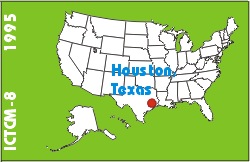
Electronic Proceedings of the Eighth Annual International Conference on Technology in Collegiate MathematicsHouston, Texas, November 16-19, 1995Paper C089Technology in School Mathematics: A Course for Prospective Secondary Mathematics Teachers |
Dovie KimminsDepartment of Mathematical Sciences Middle Tennessee State University Murfreesboro, TN 37132 USA Phone: (615) 898-2396 Fax: (615) 898-5422 dkimmins@mtsu.edu list of all papers by this author |
| Click to access this paper: |
ABSTRACT
During spring semester 1994 a new course for prospective secondary school mathematics teachers, Technology in School Mathematics, was offered at Middle Tennessee State University for the first time. MATH 331 is designed to enable prospective teachers of mathematics in secondary school to effectively integrate technology into the teaching and learning process. The content of the course focuses on the implementation of technology in mathematical content areas such as pre-algebra, algebra, geometry, trigonometry, probability, statistics, calculus, and the associated instructional strategies and mathematical pedagogy. It is required of all mathematics majors seeking a license to teach mathematics in grades 7-12.The course is organized along the theme of the roles of technology in mathematics teaching and learning. Specifically, the roles of technology as an aid in mathematical concept and skill development, as an aid in mathematical problem solving, as a aid in mathematical reasoning, and as an aid in mathematical communication are emphasized.
To emphasize the empowering role of technology the following metaphors permeate the course:
- Technology as a private investigator who gathers data to be used as a basis for inductive reasoning and conjecture forming;
- Technology as a slave who performs laborious tasks in order to leave more time for emphasis on concepts instead of computation, and whose labor will allow one to investigate more realistic problems;
- Technology as a logical communicator which when communicated with will force logical thinking and precise language;
- Technology as an ever-patient tutor.
Throughout the course prospective teachers become aware of the broad range of mathematics-specific technologies available to teachers of mathematics, and become proficient in the use of several of these by completing tutorials and experiencing using the technologies in simulated junior high and high school settings in which appropriate methodologies are modeled by the instructor. Furthermore, they gain experience in guiding the mathematical learning process with the aid of technology by making presentations to the class. Finally, prospective mathematics teachers gain a better understand of the utility of technology in achieving the goals outlined in the NCTM Standards.
Keyword(s): teacher training, software
